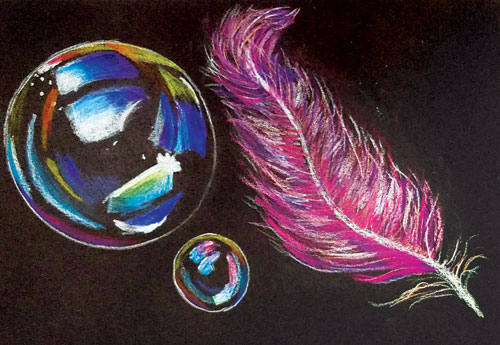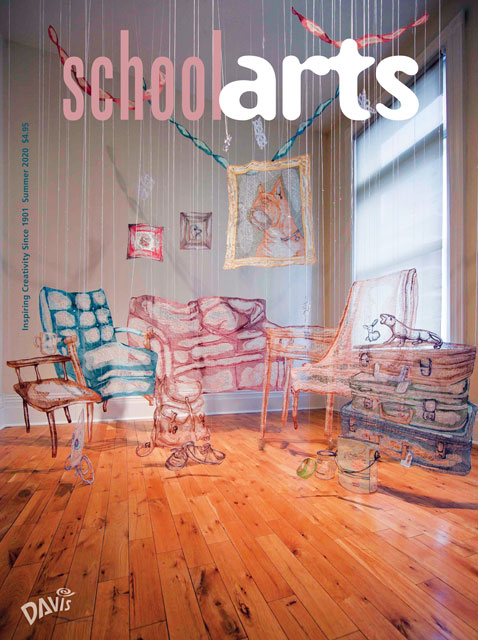 |
| Artwork from student of Ian Sands. |
Therein lies the catch. Presenting media through projects can mean spending the entire semester introducing media without ever allowing students to choose it.
Bootcamps
For those seeking to bring students up to speed on different media, Bootcamps are helpful. Bootcamps are compatible with choice teaching because they introduce the media in a short period of time. For example, a painting Bootcamp might have students spending a week learning about the proper handling of painting materials and include minilessons on color theory and brush technique.
The idea is to bring students up to speed quickly so they can use that medium in a choice-based project. Bootcamps can be more effective than teaching media through projects, but it still takes a considerable amount of time to reach the point where the student is making the choices. So, how can we introduce our class to a wide variety of media right away? Introducing the Media Fair.
The Media Fair
Think of the Media Fair like a pumped-up Bootcamp. Instead of spending a week to ten days learning one media, students spend this same amount of time being introduced to most of the common materials in the art room. Not only will students be introduced to the materials, but they’ll have the opportunity to experiment and play. They may also run through a few tutorials that provide a deeper understanding of how the medium can be applied in different situations.
At the end of the Media Fair, students will have gained an understanding of many different media. Most importantly, they’ll be able to select the material they believe will work best when creating their first choice-based project.
How it Works
The Media Fair begins on the first day of class. Each day, a new medium is introduced. Students are expected to retrieve the materials, work with those materials for that day, and then return the materials to the proper location at the end of class.
The order of materials is determined by the supplies you have available; however, starting with less complex materials has advantages. Here’s an overview of a possible tenday Media Fair:
- Day 1 graphite and charcoal
- Day 2 pen and ink
- Day 3 colored pencils
- Day 4 chalk pastel and oil pastel
- Day 5 review day open studio—any previous medium, any tutorial
- Day 6 watercolor and tempera cakes
- Day 7 acrylic
- Day 8 sculpture one
- Day 9 sculpture two
- Day 10 review day open studio— any previous medium, any tutorial
Daily Activities
The daily activities can vary depending on that day’s selected medium, but there are a few basic tasks that should be accomplished. As already noted, students should be able to retrieve the materials. In a choicebased classroom, it’s important for students to be able to accomplish this task since teachers will not be distributing materials.
Next, students should be given the opportunity to experiment with the materials on their own, so they can see what the material can do as well as learn its limitations. Students should be encouraged to push the boundaries of what they think the materials can do. It’s okay if, in the end, all they accomplish is making a big mess. It’s about the process, not the product.
Students should be provided with a method for storing their experiments. This can be accomplished by keeping work in traditional cubby spaces, or by providing students with art journals.
Mini-Lessons and Tutorials
Students should also be provided with structured activities. This way, the student learns what the capabilities of the materials are and also how to apply those capabilities. This can best be approached through mini-lessons and tutorials. For those with access to technology, there are endless tutorials available online. Other options include whole or small group demos by the teacher. Another option is to invite a local artist who specializes in a particular medium to present to the class.
Next Steps
When the Media Fair has completed, there are several options the choicebased teacher has for next steps. If students have never worked in a choice-based classroom, the teacher may want to start by offering themes as inspiration. Present students with a theme and ask them to complete tasks associated with the design phase of the artistic process, such as deciding what the subject will be, planning out their design by sketching out thumbnails, and determining which media they believe will be the best choice for bringing their idea to fruition. After the Media Fair, students should have no problem with that final task.
Ian Sands is a visual arts instructor at South Brunswick High School in Southport, North Carolina, co-author of The Open Art Room, available now from Davis Publications, and co-author of Making Artists, coming soon from Davis Publications. artofsouthb.com
View this article in the digital edition.



